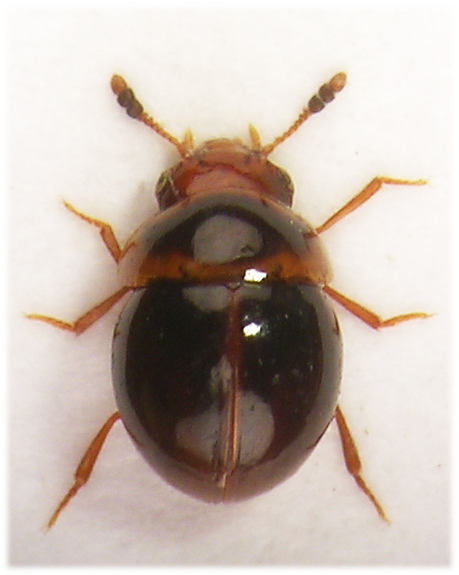
Female
Both Larva and pupa are described by Angelini and DeMarzo (1984)
2.5-3.2mm (Cooter). Very shiny and very convex with head disproportionately large. Head light to dark reddish brown, finely and sparsely punctate. Widest at weakly convex eyes, with a fine raised line from lateral margin of labrum, above eyes to base of head, temples narrowed to base. Vertex with two depressions between eyes, in our specimens the head of the female is distinctly microsculptured (X40) while in the male it is smooth. Front margin of clypeus weakly incised. Antennae inserted on front of head before eyes, 11- segmented with a 3 segmented club; segments 2 and 3 subequal, 4 elongate, 5 and 6 quadrate, 7 and 8 transverse. Light or dark brown with segments 9 and 10 darker. Pronotum highly arched and strongly transverse (average 2:1 in our specimens), finely punctate and smooth in both sexes at X40. Finely bordered laterally and basally, front and hind angles rounded. Dark brown to pichy with borders pale testaceous to brown; broadly so laterally and basally, narrowly so along front margin. Occasionally the pronotum is entirely red (There is a good photo of such a specimen in Hurka, p300); Joy gives 'th. entirely red, or with disc pitchy'. Elytra slightly broader than pronotum and appearing almost circular from above, smooth and shiny with puncturation finer and sparser than on head and pronotum. Finely bordered laterally and with a sutural striae from apex to about middle. Lateral angle, below shoulder, widely obtuse and characteristic. Dark brown to pitchy, sometimes with suture, apical area and lateral bead lighter. Legs light to dark brown, more robust in male. Tarsi 5-5-4 in male, 4-4-4 in female.
Aedeagus is characteristic; constricted at angle in front of basal part, and extreme tip upturned. Spermatheca distinctive.
British species are keyed, with gentalia figures, by Cooter (1996)
References
Cooter, J. 1996. Annoted keys to the British Leiodidae. Ent.Mon.Mag. 132:205-272.
Angelini, F. and DeMarzo, L. 1984. Morfologia dell larva matura and pupa in Agathidium varians Beck. Entomologica, Bari 19:51-60
Male
Home